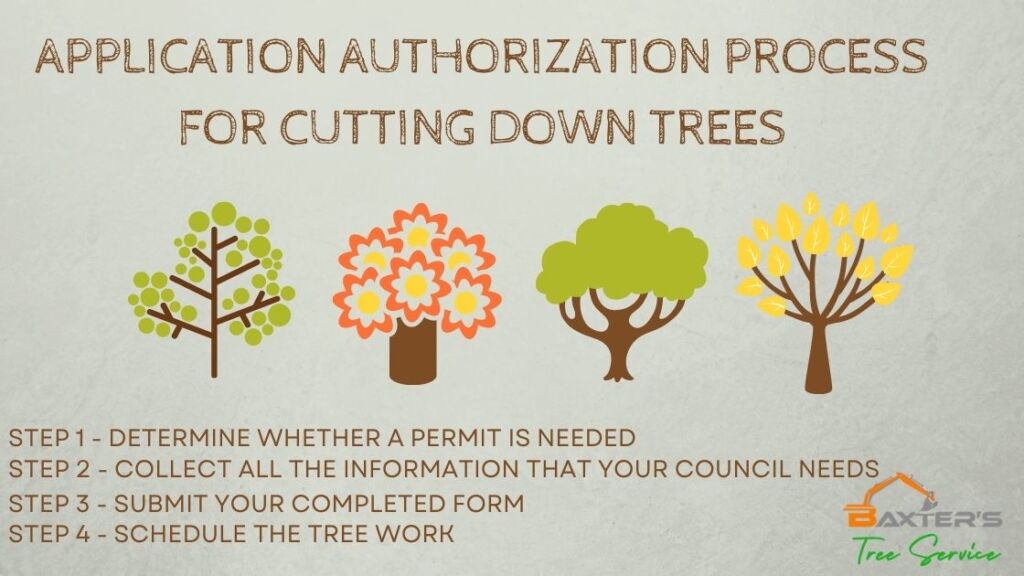


The trees on your land belong to the community even if you own your land. This distinction is appropriate because trees benefit communities in numerous ways, such as purifying the air, reducing heat islands, preventing erosion, and beautifying neighborhoods. Once your trees reach a certain height, you must ask the council for permission to cut them down. However, there are instances in which it is not necessary to obtain the council’s approval.
It won’t be necessary to get permission when your tree is:
- Dead
- Already fallen
- Hazardous
- Recognized noxious species.
- It’s in a fire hazard zone.
- It’s too small to be considered “significant”.
- If it is too close you’re your house.
To determine if it is safe to remove a significant tree, check the local council rules. Every council defines a significant tree differently, so you need to check the rules.
Application Authorization Process
Step 1 – determine whether a permit is needed
If you wish to carry out tree work on your property, the first step is to determine whether a permit is needed. Here you can find a guide to local council regulations that provide a handy walkthrough of all the requirements for requesting council permission for tree works. We encourage you to tell us if your area is not covered in these guides so that we may help you get through this process and provide you with answers to your queries. Feel free to contact us through our Baxter’s Tree Service website or by phone at (360) 503-0571.
Step 2 – collect all the information that your council needs
In order to do so, you need to collect all the information that your council needs. The specifics of what they need will differ, but you can find them on the council website. For most rules, you will need to answer questions regarding the tree size, location, condition, and tree species, determine the fire zones, and check if there are any relevant restrictions, such as vegetation overlays and significant tree registry regulations. Applicants need to submit a Pro Arborist Report with the tree removal application to verify the accuracy of the information and provide further details about the tree and the proposed tree work.
Keep in mind, having a qualified arborist on the job can significantly simplify the process. Furthermore, they can help gather all of the relevant data and offer valuable experience in dealing with council applications in addition to the Pro Arborist Report.
Step 3 – submit your completed form
Step 3 of the process involves submitting your completed form along with the Pro Arborist Report and the stated fee. It usually takes a couple of days to a couple of weeks for these applications to be processed. So, please wait until you have received confirmation of council approval before scheduling any tree works.
Step 4 – schedule the tree work



Having received the council’s approval, the fourth step is to schedule the tree work for your property.
Some Lame Excuses that can Make Your Application Rejected
“Why did I get my application rejected?” I see this question pop up quite often, and it is vitally important, especially when it comes time to apply for a permit for removing a large protected tree. It is worth mentioning that councils always prefer to save trees first, so if your justification is weak, your application will be denied.
Below is a list of bad reasons that will prevent your application for tree removal from being accepted:
- There are too many leaves falling from it.
- I have blocked gutters because of leaves.
- I’m having trouble draining because of roots.
- My lawn gets too much shade.
- I can’t get my lawn to grow.
- It’s awful, I totally dislike it.
As you can see, these above issues are small ones, and the council officer will probably have a chuckle at himself and deny your application.
Tree Permit FAQs
Could I be prosecuted if I cut down a tree without permission?
A homeowner or business owner cannot cut trees on their own property without permission. There is a possibility of legal repercussions for violating the local tree protection rules.
An arborist’s permit to remove trees costs how much?
Local laws, rules, and regulations vary from jurisdiction to jurisdiction. As a deterrent against tree cutting, some parts of the state charge high fees for these types of permits. Additionally, trees near protected areas can incur additional fees. However, the cost of applying for a tree service job will average between $100 and $200 on average.
Is there a need for planning permission for pruning trees?
It depends on the state and local laws in your area if you want to cut down a tree. Whenever you plan to do any tree work, you should ask for official approval before starting. Generally, a tree removal job involving a significant amount of tree material requires prior approval per tree protection law.
How much does it cost to remove trees?
There is a range of rates that loppers (another name for an arborist) will charge depending on where you live and how big and how well the tree is. However, getting your tree trimmed costs on average $460, with most people paying between $200 and $760.
Will the council remove the tree for us?
I’m sorry, but no. Trees on public lands, such as those in parks and nature reserves, will be the only ones that the council may disturb. Ironically, the overlords can grant or deny you permission to remove a tree, but you still need to pay for it once they have granted it.
The Bottom Line
Now if the tree poses an immediate threat, an arborist with at least AQF Level 3 in Arboriculture must produce a detailed report identifying any imminent risk to human life or property. In addition, it must include a forecast of when an imminent tree failure is most likely to occur and whether it requires immediate action.
Included in the list of imminently dangerous risks are:
- Obvious signs of root instability.
- An indication of soil heaving or cracking.
- Rotten roots/loss of structural roots.
- Weather-related damage.
- Structure-related defects, such as a split branch.
However, false reporting about the condition (dead, dying, in imminent danger) of a tree can result in heavy fines and legal action by local governments.

